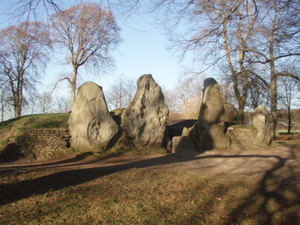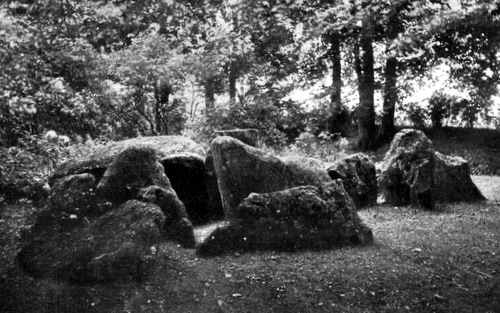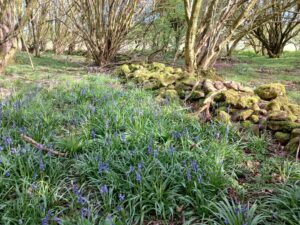
a burial chamber dating back to Neolithic times

Wayland’s Smithy is one of the most impressive and atmospheric Neolithic burial chambers in Britain. Somehow this ancient grave became associated with Wayland, the Saxon god of metalworking, from whom it takes its name.
History
The burial chamber underwent two distinct phases of construction,
identified during excavations in the 1960’s. In the first phase an oval
mound was erected, which covered a wooden and stone structure with a
floor paved with Sarcen stones. The remains of 14 bodies were found from
this period, all badly damaged as if the roof had fallen in on them. No
part of this structure now survives, as it was incorporated into the
mound seen today.
In Phase 2, started around 3500BC, the mound
was enlarged to the trapezoid shape using earth from two flanking
ditches, which are no longer visible. The mound was edged with Sarcen
slabs, and had a facade of 6 larger stones (two of which are missing) at
the Southern end. A stone lined passage was built within this Southern
face with two chambers forming a cruciform shape.

Legends and Folklore
The burial chamber is named after Wayland the Saxon god of metal working, although he is often seen as one of the elven race rather than a god. Wayland is the same as Volundr or Volund, who is described in Norse myth, recorded from Iceland in the form of a poem. Volundr is a smith of outstanding quality, his work is so prized that a vain king called Niduth lames him and sets him to work on an island. In revenge Volundr kills the King’s two greedy sons, fashioning goblets from their skulls. He then rapes the King’s daughter, and fashions wings with which he escapes from the Island. Before he flies off to Valhalla he lands on the archway of the palace and reveals the nature of his revenge to the King and his subjects.
It is likely that this myth travelled with the Anglo Saxons, and the tomb became associated with Wayland because of its uncanny quality. It is well known that the art of the smith was shrouded in secrecy, legend and magic, and many ancient monuments became attributed to supernatural figures. Volundr is also associated with labyrinths, and it has been suggested that the resemblance of the dilapidated tomb to a labyrinth may have led to its association with the smith god.
Traditionally, Wayland still inhabited the mound and was ready to shoe a horse. The horse had to be left at the mound alone for a short period, along with the payment of a silver coin. On returning the horse would have been shod and the payment would have disappeared.





